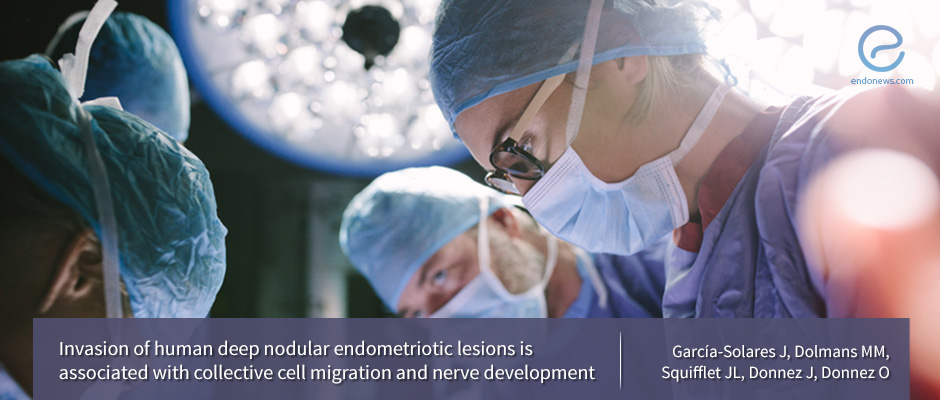Conservative Surgery May Be Sufficient to Halt the Development of Deep Endometriosis
Jan 28, 2019
A biological process called collective cell migration may dominate gland invasion in endometriotic lesions and therefore disrupting this process with conservative surgery may be sufficient to halt disease progression.
Key Points
Highlights:
- This study sheds light onto the mechanism of how deep endometriotic lesions invade other tissues. It shows that a biological process called collective cell migration may play a key role.
Importance:
- This finding suggests that conservative surgery where the shaving technique is used may be sufficient to halt the progression of the disease without the need for more drastic approaches such as bowel resection.
What's done here:
- Researchers analyzed biopsy samples of deep endometriotic lesions obtained from women who underwent surgery for deep endometriosis.
Key results:
- Glands from the front of the lesion were significantly thinner but more proliferative than those in the center.
- E-cadherin levels were significantly lower while N-cadherin levels were significantly higher in glands located at the front of the lesions compared to the center of the lesions.
- Matrix metalloproteinase-9 expression was significantly higher in the front of the lesion compared to the center.
- The expression of nerve fiber density factor and nerve growth factor were significantly higher in the front of the lesion compared to the center.
- β-Catenin expression was similar between the front and center of the lesion.
Limitations:
Although the findings of this study support the idea that conservative surgery using the shaving technique may be sufficient to treat deep endometriosis more research is needed that clinicians can base their therapeutic decisions upon.
Lay Summary
Deep endometriosis develops as a result of collective cell migration and nerve recruitment from surrounding organs, suggests a study published in the scientific journal Fertility and Sterility.
Collective cell migration is the biological process whereby a group of cells moves together without disrupting their contacts with each other. During collective cell migration, a connection between the cells in the center of the group and the so-called invasion front is essential for migration.
So if collective cell migration is the main process that dominates the invasion of deep endometriosis, if the center of an endometriotic lesion is removed with surgery the remaining glands may not be able to further develop. The authors of the study propose that their findings support the use of conservative surgery as opposed to more radical approaches that involve bowel resection for the treatment of deep endometriosis.
In order to study the mechanisms of invasion and innervation (or nerve supply) of deep endometriosis, the team from Belgium and France analyzed 17 biopsy samples of deep endometriotic lesions obtained from women who underwent surgery for deep endometriosis.
They assessed the samples morphological i.e. by looking at their shape and using laboratory techniques to analyze different proteins that they produced. They divided the samples into two parts. The first part consisted of the front of the lesion, which is the most invasive, and the center of the lesion, which is the area close to the posterior part of the cervix.
They found that glands that were situated in the front of the lesions were significantly thinner than those in the center of the lesion but that they proliferated more.
The front and the center of the lesions were also different in terms of the expression of cell adhesion molecules. For example, the front of the lesion had significantly lower levels of E-cadherin and significantly higher levels of N-cadherin.
However, there was no significant difference in the levels of β-Catenin between the front and center of the lesions.
Cell adhesion molecules are molecules that keep cells together and allow them to communicate with each other. Maintaining cell-cell contact during the invasion process is one of the main features of collective cell migration and the findings support the role of this biological process in the development of deep endometriosis.
In addition, the expression of matrix metalloproteinase-9 was significantly higher in the front of the lesion compared to the center. Matrix metalloproteinases are enzymes that are responsible for the degradation of most extracellular matrix proteins. Previous research has shown that they are involved in the development of endometriosis. The fact that their expression is higher in the front of the lesion supports their role in the invasion process of deep lesions.
Finally, nerve growth factor and nerve fiber density factor were significantly higher in the front of the lesions. This supports the role of nerve growth factor in recruiting nerves from surrounding organs to the lesion and could explain why deep nodular endometriosis is much more painful than other forms of the disease.
Research Source: https://www.ncbi.nlm.nih.gov/pubmed/?term=30503131
Deep endometriosis collective cell migration cell adhesion innervation deep tissue invasion conservative surgery shaving technique

